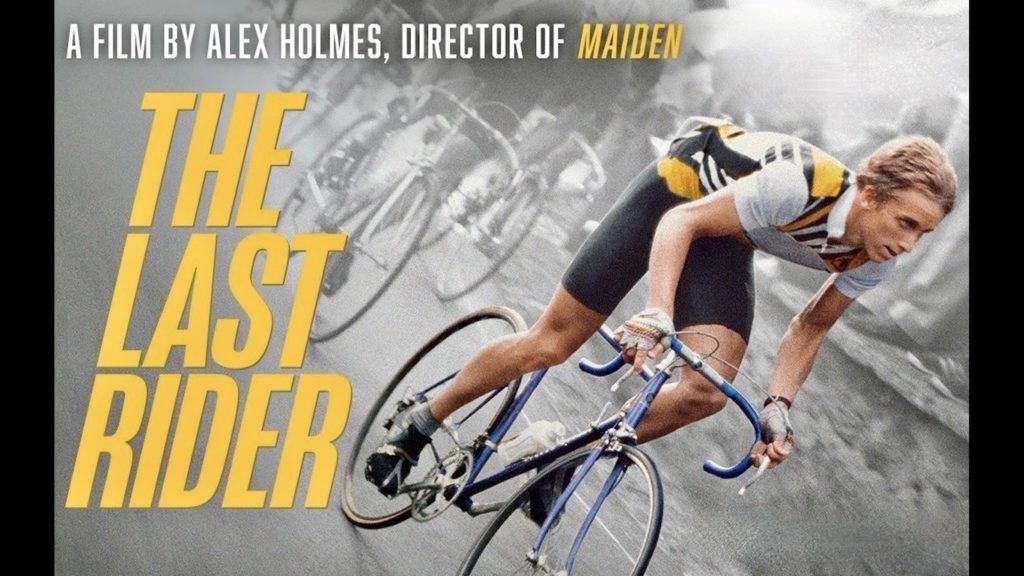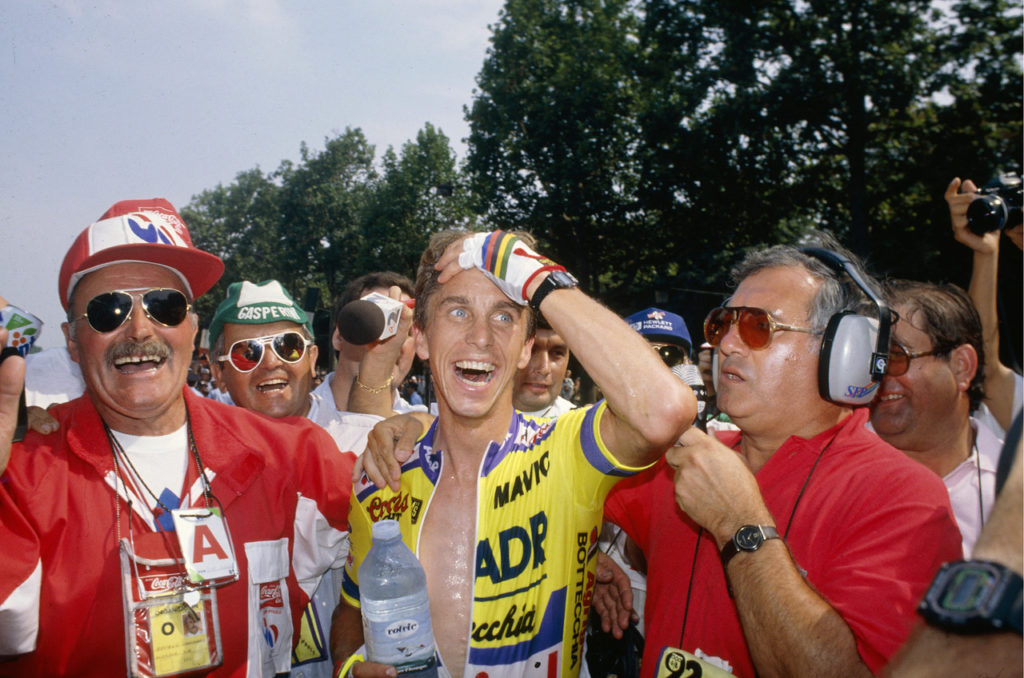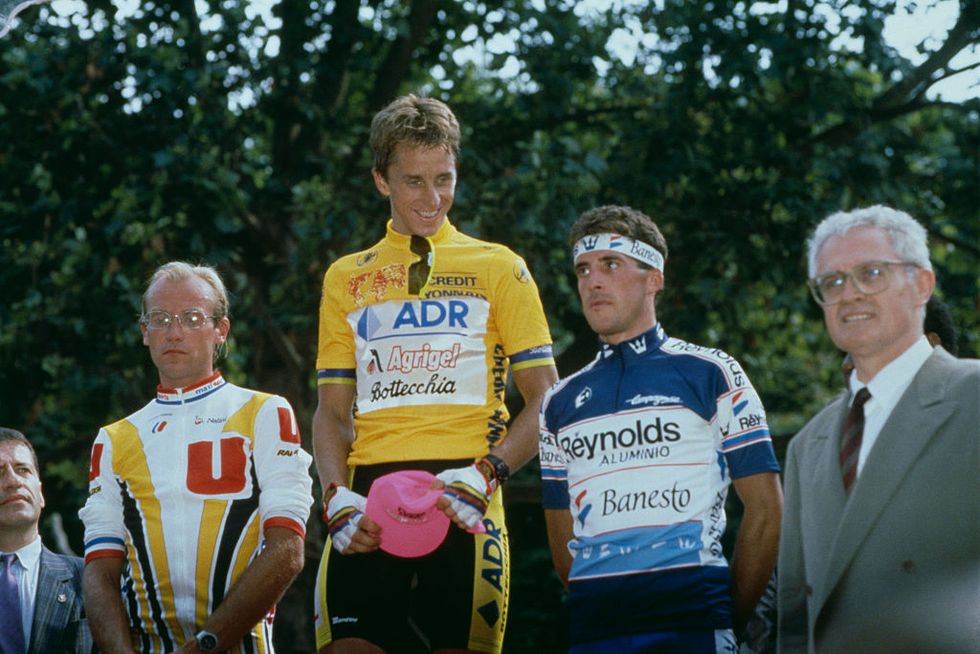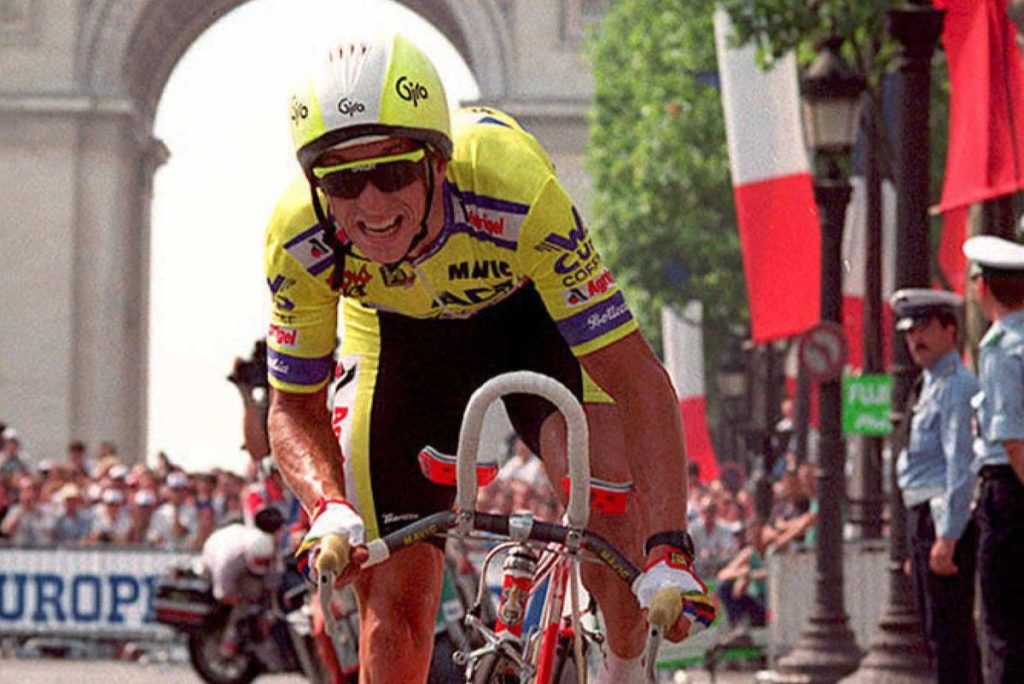
Diet And Weight Loss To Make You Faster
Nutrition and food choices are a key component of weight loss for all endurance athletes, including cyclists. When done correctly, weight loss can have a huge
By Kate Agathon

“Very strange things happen in cycling.You can’t count a race as won until the last minute,” Spanish cyclist Pedro Delgado says dryly to the camera in The Last Rider (2022).
The 1988 Tour de France (TDF) champion’s remarks could not more aptly describe the historic 1989 TDF in which one of the greatest moments in cycling (nay, sports) history took place.
That year, American Greg LeMond nabbed the maillot jaune from France’s Laurent Fignon in the final time trial, ultimately winning cycling’s most prestigious event in what remains as one of the biggest sports upsets of all time.
For three weeks and over 2,000 miles, LeMond and Fignon had duked it out on the world’s biggest cycling stage.
Across the flats from Poitiers to Bordeaux, and in the mountain stages over the Pyrenees and the Alps, the duo battled.
With neither rider giving in, the final days were dramatic. Although LeMond won Stage 19 Villard-de-Lans to Aix-les-Bains, Fignon was in the lead for GC. Then the final time trial happened.
With a 50-second lead over LeMond going into the final time trial, the egotistical Fignon was confident in winning his third TDF title (he had previously won in 1983 and 1984), and had already begun to celebrate on the train to Paris the night before.
According to Fignon’s directeur sportif Cyrille Guimard, the premature pouring of champagne was partly Fignon’s way of continuing to aggravate his rivals, but also to hide an embarrassing secret- Fignon was suffering from saddle sores.
Despite Fignon’s physical pain, in their arrogance, neither Guimard or Fignon ever dreamed that LeMond would overtake his lead in the individual time trial (Fignon himself was an adept time trialist). To overcome such a deficit was simply not done and unheard of- until LeMond.
Clad in a specially designed aero helmet and riding a time trial bike tricked out with aero bars and a rear disc wheel, and unaware of his opponent’s affliction, LeMond rode the final day with a nothing-to-lose audacious intensity.
The effort LeMond put in was incredible, and he emerged victorious.
In the end, a mere eight seconds separated first place (LeMond) from second place (Fignon), while defending TDF champion Delgado took third. To this day, eight seconds remains the smallest winning margin in the race’s history. LeMond’s focus resulted in the fastest ever time trial in TDF history and cemented his TDF legacy.
That year, Fignon was not the only one keeping a secret.
What no one realized was that leading up to his amazing comeback, LeMond himself was also concealing a secret; an assortment of psychological and physical traumas that had tortured him for years.
America’s only TDF champion
 The Last Rider focuses on the historic 1989 TDF and LeMond’s personal life leading up to it (the title refers to Guimard’s remarks about ‘LeMond as the last clean great American rider before EPO and the Lance Armstrong era’).
The Last Rider focuses on the historic 1989 TDF and LeMond’s personal life leading up to it (the title refers to Guimard’s remarks about ‘LeMond as the last clean great American rider before EPO and the Lance Armstrong era’).
What makes The Last Rider unique is that it juxtaposes the public facade of LeMond the G.O.A.T. with the relatively unknown private side of LeMond the Survivor.
“In The Last Rider we get to see what was going on in the background. Trauma changes a person, and unknown to most, I had suffered a lot,” said LeMond from his home in eastern Tennessee over a recent Zoom interview.
“All people saw was success. But there’s a moment you hit a breaking point,” he continued.
That breaking point happened in the 1986 TDF when former teammate and five time TDF winner Bernard Hinault famously betrayed LeMond after publicly declaring the previous year that he would support LeMond to victory.
The agony of the psychological stress dealing with Hinault opened up a wound for LeMond that for the first time as an adult, he was forced to address: he was a victim of sexual assault.
For years, he had kept the trauma resulting from the sexual assault a closely guarded, terrible secret that he did not even reveal to his wife, Kathy.
In addition to the psychological trauma, he also had to contend with physiological trauma from a devastating incident in which he had been accidentally shot with a shotgun.
Compounded with depression, shame, and other dysfunctional family dynamics taking place at the time, he silently tried to manage his layers of trauma alone as he fought to regain top place among the world’s most elite cyclists.
Being alone while trying to win the GC title at the TDF was not an enviable position to be in.
After Hinault’s duplicity became apparent in 1986, a determined LeMond had ridden to victory without the help of his former teammate. Additionally, he rode defiantly in the face of dark rumors among the peloton of others sabotaging his (LeMond’s) performance throughout the remainder of the race.
In 1989, he found himself largely riding alone again as no one had considered him a serious contender for the GC throne and his team was relatively weak.
Without a reliable domestique, LeMond not only had to rely on his own grit to get through the grueling stages of the 1989 TDF, but he also had to contend with the trauma he had bottled up deep inside. Those factors combined may have made him the most successful, yet loneliest rider in the TDF peloton that year.
Due to the lack of support and the resources he needed to win, LeMond’s resilience and ensuing victory in the 1989 TDF made his feat even more remarkable.
LeMond’s backstory during that time is as much a part of his victory as the final time trial.
“The film is more about the backside story than me winning. I think it is better to understand that side of my career other than just my race victories,” LeMond said emphatically.
Working with Holmes
 You think you know LeMond’s story? Think again. What makes The Last Rider good cinema is the storytelling.
You think you know LeMond’s story? Think again. What makes The Last Rider good cinema is the storytelling.
The world is familiar with LeMond’s persona as America’s greatest cyclist, but what about LeMond the survivor and victim’s advocate? The personal struggles he faced outside of cycling?
This is where The Last Rider reveals the complexity of LeMond. Here, we explore the B Side of his champion story- all of which came to a head in 1989.
The Last Rider is written and directed by BAFTA award winner Alex Holmes. No stranger to writing/directing documentaries (Holmes wrote and produced 2014’s riveting Stop at Nothing: The Lance Armstrong Story), Holmes takes the audience on a deep dive into the stories you already knew (LeMond getting shot during a hunting trip, Hinault’s deception in the 1986 TDF, etc.).
According to LeMond, Holmes approached him with the idea of doing the film four or five years ago.
“I was reluctant. I’m kind of going, I’ve heard this story over and over,” he said. “But Holmes explained that he wanted to show a more personal side, the other side of my story. For example, when I got shot, I had to pretend I wasn’t really that injured just so I could stay on the team. And I think he wanted to tell that story about me going from winning the TDF to almost quitting the sport and then winning. ”
“And then I said that’s what I’d like. I wouldn’t like a puff piece that was like, you know, I won the TDF in 1989. That was really a great victory, but it was overcoming a lot of stuff that led up to it that I’m more proud of than even that victory,” LeMond explained.
Production took place during the pandemic, and all the interviews were done remotely.
“It was great working with him. He wants to tell emotional stories and make movies that might touch other audiences. There’s a lot of people who are not cyclists who will like the story and I think that’s what his goal was with The Last Rider. He really put this together, he really did,” he praised.
Everyone is vulnerable
Holmes also presents a closer look into personal revelations that LeMond had kept undercover for decades and that had marred his first TDF win in 1986.
Shortly after his win, LeMond’s trauma resurfaced and he was afraid his abuser would speak out now that he had become world famous. Depression later ensued.
“I had no joy from that victory,” he said. “To win the TDF was my dream. But no one knew what I was going through physically and psychologically.”
Cycling was LeMond’s physical and mental outlet, and he was exhausted from the emotional trauma. “It (trauma) was always there. It comes back to hit you,” he said.
LeMond’s public disclosure about the sexual abuse only happened several years later, during an arbitration hearing for disgraced American cyclist Floyd Landis in 2007.
Audiences, however, are more familiar with another devastating event that created even more trauma for LeMond and, by extension, his family. In 1987, at the peak of his fitness, he was accidentally shot by his brother-in-law, Patrick Blades, during a family trip to hunt turkeys.
As a result, LeMond lost 25 pounds of muscle mass, three quarters of blood, and suffered a collapsed right lung.
Deep depression, sudden financial worries (he was unceremoniously dropped from his team), and strained family relations (Blades felt so remorseful for shooting LeMond that he threatened to take his own life and was temporarily put into a psych unit at another hospital), presented LeMond with the darkest two years of his life.
“The stress was incredible. There were a lot of down days and I cried during many of them,” LeMond said.
Eventually, he realized that he needed to ride, and resolved to ride in the TDF once more.
Going into the 1989 TDF, he competed with 45 lead pellets remaining in his body- including three in the lining of his heart and five more embedded in his liver.
“I don’t think people have really appreciated the serious injury that I had. And it has kind of been discounted and it set me up because I had to pretend I wasn’t that injured,” said LeMond.
“So it set me up so that when I wasn’t performing, they’d look at me and say I wasn’t being professional, I wasn’t training right, I wasn’t eating right. Which was the opposite- you don’t win the tour without knowing how to do it.”
“And it set up, even to this day, the idea that I’m the one who set the example of focusing solely on the TDF as my only goal. That was out of survival, not intention. I loved The Classics, I wanted to do every race!” he exclaimed.
LeMond continued, “I would have loved to have seen what my career would have been like without the accident. I think I would have been a better palmares and my resume would have been a lot stronger. I guess I’m fortunate that I even got to race again.”
While the struggles LeMond had to overcome to win the 1989 TDF were substantial, so was his rivalry with Fignon.
Rivalry for the ages
Professional cycling has its share of rivalries (Fabian Cancellera versus Tom Boonen; Mathieu Van Der Poel versus Wout Van Aert, etc.), but LeMond’s rivalries with Fignon and Hinault are legendary.
Cancellera versus Tom Boonen; Mathieu Van Der Poel versus Wout Van Aert, etc.), but LeMond’s rivalries with Fignon and Hinault are legendary.
“Anybody who threatens me or bullies me, I’m done. I will go for the throat!” LeMond exclaimed.
And LeMond did. With voracious tenacity.
Like a favorite book to be re-read (even if you know the ending by heart), cycling fans can’t get enough of revisiting the dramatic 1986 and 1989 Tour de Frances.
As an aficionado of cycling films (Slaying the Badger, Band of Brothers, and All for One remain favorites), I’ve seen numerous films telling the incredible story of LeMond. However, The Last Rider differentiates itself because it is so masterfully done you can’t help yourself but get caught up in the moment.
Imagine a TDF where one team’s support vehicle sideswipes the other like a bumper car to prevent them from speeding ahead to share crucial information about their opponent (LeMond’s team support car managed to hold off Fignon’s for 1 or 2 kilometers on the Alpe d’Huez).
Or one where the GC is criticized by other GC contenders (Delgado and Fignon) for the perceived unsporting behavior of “not riding like a GC.”
During the last 20 minutes of the film, I found myself literally sitting on the edge of my seat, booing at the arrogant Fignon (cycling’s equivalent to Draco Malfoy) and cheering loudly when it became apparent to LeMond that, against all odds, he had won his second TDF.
Even though I already knew the outcome, I was so invested in LeMond’s journey that by the time the showdown in the final time trial arrived, I had teared up in emotion. I felt myself living in the moment of a victory that happened 35 years ago this July. LeMond wins!! Yes!!!
For LeMond, winning the TDF was a relief.
It not only healed his inner pain and uncertainty in his return to racing, but healed the uncomfortable rift in the LeMond family that had been omnipresent following the shooting incident in 1987.
Deep dive
The 1989 TDF is one of the most memorable cycling events of all time.
LeMond had been absent from professional cycling for two years. He entered the race with a new team, a damaged body, a new mindset, and a formidable foe in Fignon. Many of the obstacles he had to overcome were unknown to the public and makes LeMond’s comeback story even more incredible.
While he continued to struggle silently with trauma, LeMond’s legend as a cyclist grew. After his 1989 TDF win, he donned the rainbow stripes when he won the World Championship that August, and won his third and final TDF in 1990.
In the aftermath of Armstrong’s stunning confession of doping in 2013, LeMond’s comeback story from the brink of death is even more compelling and his staunch anti-doping
stance even more respected.
A man of firsts
LeMond is a man of firsts.
First and foremost, the first and only American cyclist to win the Tour de France multiple times.
Before Tadej Pogačar’s stunning time trial win over Primož Roglič in the 2020 TDF (thus winning the stage and GC), LeMond did it first. Before Jens Voigt made his moral anti-doping stance public, LeMond spoke out first.
Finally, several years after LeMond revealed that he was a victim of sexual abuse, 2012 TDF winner Sir Bradley Wiggins also opened up about being a victim of sexual abuse (he was abused at the same age Greg was) and its impact on his life. Like LeMond, he used cycling as a coping mechanism.
It seems fitting that The Last Rider was made during a time in which elite athletes are becoming more vocal about abuse they have suffered at the hands of others (i.e. Larry Nassar and members of the U.S. Olympic women’s gymnastics team), and have no qualm publicly discussing the stress from unseen grief or trauma they endure under immense pressure while competing (i.e. Simone Biles, Mikaela Shiffrin).
After seeing The Last Rider, I won’t quite view cycling’s elite in the same way again. Is LeMond sympathetic to 2019 TDF winner Egan Bernal, who suffered a horrendous training crash in 2022? What unseen struggles are cycling’s current stars dealing with?
For LeMond to reveal his vulnerabilities in a feature-length film and share a behind-the-scenes-look where things were not so rosy, takes immense courage.
His unwavering anti-doping stance during his entire career and afterwards (i.e. Armstrong’s vicious attacks) took courage. His personal truth only adds to his cycling legend, making his stories one of the greatest in sports history. Sharing his struggles doesn’t damage the luster to his legacy at all, it only enhances it.
I hope The Last Rider eventually becomes available to stream or rent, because this is the type of film you watch multiple times. Masterfully done, it is a must-see for cycling aficionados and sports enthusiasts. Engaging like no other, The Last Rider is a film that you will not want to miss.
One week shy of 62, LeMond no longer keeps secrets tucked away.
“I’m an open book! I’ve been to therapy, my wife has been incredibly supportive. I’m not ashamed of what’s happened to me in the past and I’m pretty proud of what I’ve done,” he proclaimed.
As for his thoughts on The Last Rider?
“I think people will like it. Stories are timeless. Cycling is an incredibly exciting sport and there’s a human side that they get to see,” finished LeMond.
See the film
Just in time for the 2023 TDF, The Last Rider (2022) drops in theaters across the country on June 23.
More information can be found here. Along the Front Range, The Last Rider will screen at Century 16 in Boulder, Cinemark 16 in Fort Collins, Westminster Promenade 24, and Tinseltown 20 in Colorado Springs.
Watch the trailer here: https://www.youtube.com/watch?v=9kWF4FmllqM

Nutrition and food choices are a key component of weight loss for all endurance athletes, including cyclists. When done correctly, weight loss can have a huge

Photos are rolling from Mt. Blue Sky/Bob Cook Memorial Hill Climb p/b Team Evergreen on that was held this past weekend. The day lived up

Pad Thai is a popular street food in Thailand, which is whipped up quickly and packed full of flavor. It’s one of our favorite post-ride

Tubless Tires: Myth or Magic? Justin Bolinger of I Know a Guy Bicycles “UNBOXES” the Truth about this setup (Should you go Tubeless?) Recent Posts

Last week, Douglas County hosted the Natural Grocers Criterium at their sheriff’s training facility, and the camera of Ryan Muncy/Ryan Muncy Photography was on the scene

When you are looking to refuel at lunchtime, go for carbs and quality protein – this pasta dish is ideal. Cycling takes energy, and energy come